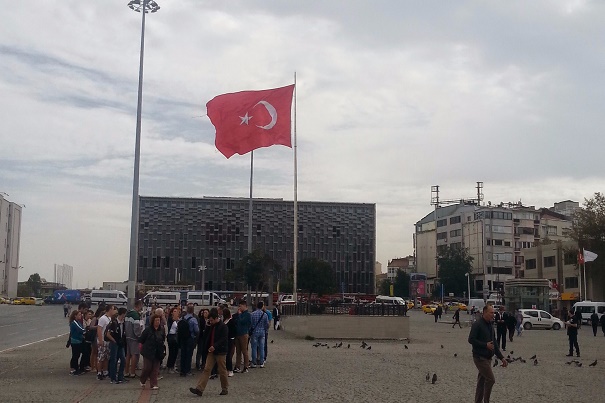
Author's note: this article was written after a trip to Istanbul in October 2014, but not previously published
“If anyone tells me that Taksim is a perfect square, then I would tell him that it is the world’s ugliest square,” Turkey’s Prime Minister Ahmet Davutoğlu told journalists in on a flight on 19 October, as reported by the English-language Hurriyet Daily News.
Having spent the last seven days in an apartment two minutes’ walk from Taksim, I can see Davutoglu’s point. It’s an odd, uneven space. The traffic system is baffling. The Ataturk memorial that should be a focal point of the piazza seems both too small and in the wrong place. An enormous Turkish flag waves over the square, but there are enormous flags everywhere in the country, to the point where the impact is a little lost.
Davutoglu’s musings may be about more than just his views on city planning. Plans to remodel Taksim, and in particular to build over Gezi park, a small green corner of the square, sparked protests in May 2013, bringing global attention to discontent felt by some at the AK party’s reign in the country. The Islamist AK’s 11 years in power, led by Recep Tayyip Erdoğan, first as prime minister and then as president, have been characterised by internet and press censorship and what many fear is a creeping social conservativism supported by the AK party’s Islamist leanings.
The press in the past few days has been dominated by the latest twist in what is still referred to as “the Kurdish question”, and Ankara’s will-they, won’t they manoeuvres on the issue of military assistance to the Kurdish groups fighting the Islamic State just over the Syrian border. President Erdoğan is in an admittedly tough situation; caught between international pressure from Nato allies to stop the spread of IS, and an unwillingness to be seen as soft on the separatist Kurdistan Workers’ Party (PKK). Erdoğan’s government has been in negotiations with the PKK leader Abdullah Ocalan, but the group is still classified as a terrorist organisation. Erdoğan has said in recent weeks that for Turkey there is no difference between the PKK and IS, and earlier this month, the Turkish Air Force even carried out strikes against PKK positions on the Iraqi border.
That the newspapers can even have discuss relations between Ankara and the PKK in the open could be seen as a sign of progress; not so long ago, the domestic media would not even have used the words “Kurds” or “Kurdistan”, for fear of violating parts of the country’s laws on “insulting Turkishness” and glorifying terrorism.
That is not to suggest a new found era of freedom. Every day, the papers carry new, worrying stories: the head of the state theatre company resigns after the Ministry of Culture and Tourism demands that references to sex are removed from a new production; A cartoonist for the respected Cumhuriyet (“Republic”) newspaper faces more than nine years in jail for a caricature of Erdoğan, after a prosecution is brought by the president himself; the government’s new security bill could bring new powers to curb dissent on social media.
Meanwhile, in Istanbul, the only visible remnant of the 2013 protests are the water cannon stationed at Taksim and outside the gate of Galatasaray University, on the city’s permanently busy Istiklal Street. Armed police gather at points along the 1,400 metre street, some with gas masks and riot shields ready.
At midnight, police jeeps rolled into Taksim. Sirens blare and megaphones hector, but there is not a protester in sight. The police are here to clear the square of the barefoot child beggars who populate it day and night, many squatting and blowing tunelessly into cheap melodicas in the hope of earning a lira. The children run, giggling up the hill to Gezi, to briefly hide behind trees. The police do not emerge from their vehicles to give chase. Both sides know this is a game.
Where are the protesters? Is there a Gezi legacy? All that has gone indoors, one Istanbuler tells me over tea (the endless, endless tea rounds of Turkey). Conversations about dissent happen, but the calls to action have been successfully stifled. Politics feels a little like something that is happening elsewhere, to some other people.
And besides, what could the legacy be? As with the Occupy movements around the world, the Gezi protesters seemed to lack a plan, a programme. The act of protest seemed to be an end in itself.
On Monday, we attempt to visit the press museum, which the guidebook promises will feature a short history of the Turkish media plus tributes to journalists killed in the country, including Istanbul Armenian Hrant Dink, killed in 2007 whose still-published newspaper, Agos, we pick up at a stall on the way. We are told the museum is closed and to come back tomorrow.
On our return the next day, a few more rooms are open, but they contain only printing presses and other pieces of equipment - nothing on the history, the people or the stories that made the Turkish media. I attempt to take a photograph, but the press museum attendant angrily barks “No Photo”, the irony apparently lost.
The metaphor of the still presses gathering dust in silent rooms overseen by an unsmiling Commissar is tempting but false. Life goes on in Istanbul, and the presses keep rolling. But with everyone I speak to, there is an air of resignation, that this is how life is now. Could it be worse? Probably. But there’s no sense from anyone that things are about to get better anytime soon.